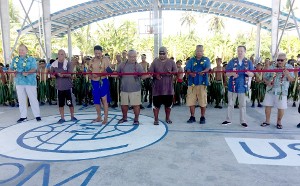Press Release Shim
Speeches Shim

For Immediate Release
United States Agency for International Development (USAID) Pacific Islands Office Chief of Program Resources Management Robert Barton, USAID Pacific Islands Engineer Robert Pierce, and the Federated States of Micronesia (FSM) government officials marked the completion of homes and public infrastructure destroyed by Typhoon Maysak.
The ceremony took place at Outer Island High School, Falalop Island, a school that USAID rebuilt along with over 60 other public facilities and 90 new homes in Yap. To boost livelihoods, USAID trained over 200 local residents to help with reconstruction efforts, which included resilient designs and high quality materials so that the buildings can withstand future disasters. Additionally, USAID provided materials and vouchers to nearly 200 people whose homes and possessions were damaged and whose livelihoods were threatened.
“Our event today is not just about completing construction projects. We are also celebrating how our governments, non-governmental partners, and beneficiaries now have greater capacity to prepare for, respond to, and recover from disasters,” said Barton.
USAID and the Government of FSM coordinated with the U.S. Federal Emergency Management Agency, the Department of Agriculture, Food and Nutrition Services, and the Small Business Administration for this reconstruction program, which was implemented by the International Organization for Migration. Following the ceremony, Barton toured a USAID project that is helping five communities in Yap’s main island reduce their risk to disaster. The project, implemented by Catholic Relief Services, also helps families start growing their own food, pursue new livelihoods, and save money for emergencies to build their resilience to disasters.
Through this and other projects, USAID is partnering with communities to conserve biodiversity, prepare for disasters, and better manage natural resources. In a move to advance Micronesia’s ability to develop and sustain its own environmental resilience, USAID is also helping government, private sector, and civil society organizations gain access to international funding for projects that mitigate the impacts of natural disasters.
In the Pacific Islands, USAID partners with national governments to advance sustainable, resilient development. USAID assistance in the Pacific Island region covers 12 nations: Federated States of Micronesia, Fiji, Kiribati, Nauru, Palau, Papua New Guinea, Republic of the Marshall Islands, Samoa, Solomon Islands, Tonga, Tuvalu, and Vanuatu.

Comment
Make a general inquiry or suggest an improvement.